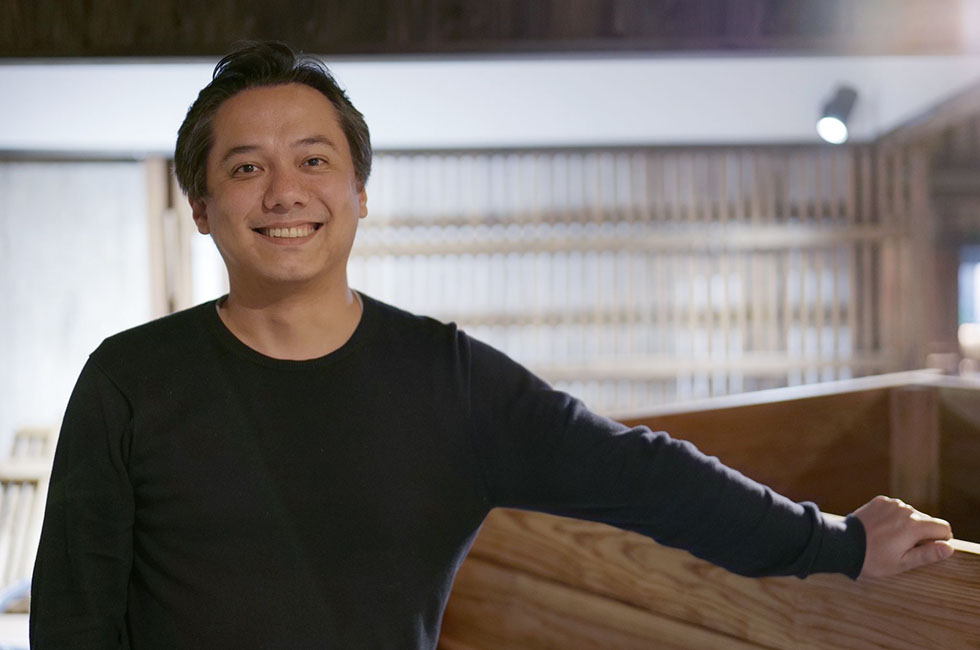
Narai-juku Project
for Utilization of Old Houses
"BYAKU Narai" opened in August 2021 as a small complex renovated from a traditional house, with accommodation (total 12 rooms), a restaurant, a bar, a hot spring bath facility, a gallery for promoting local culture, and a sake brewery. Since it opened, the number of repeat customers has gradually increased, and it has received good reviews. This section introduces the community development project that Takenaka Corporation and Shiojiri City have worked on together with various stakeholders to revitalize the appeal of Narai-juku.
Creating win-win relationships with stakeholders
Our company has devised the Forest Grand Cycle, a sustainable, virtuous cycle of forest resources with the local economy, and have actively promoted construction of wooden buildings as well as worked with various stakeholders to establish this cycle. As stable procurement of large amounts of timber is essential for the construction of these wooden buildings, we have been seeking connections with partners such as forestry cooperatives and tree producers.
This collaboration with Shiojiri City, Nagano Prefecture, was prompted by the fact that the technology that supports our company’s large-scale wooden constructions, Moen-Wood, is made of larch from Nagano Prefecture, and Nagano City also has a large-scale biomass power plant, making it a "hot spot" where trees are actively used.
Shiojiri City, on the other hand, was facing the problem of an increase in the number of vacant houses due to depopulation caused by a decline of the forestry industry. In response, our company proposed an idea whereby the know-how and networks we have cultivated in various urban creation activities through our MACH Innovation* initiatives could also be utilized in Shiojiri City. As a public-private partnership project, Shiojiri City would raise public funds, and our company and other private companies would jointly establish a “town development company” to provide planning and operating know-how for revitalizing the city.
As a first step, our company established Salt Terminal Co., Ltd., a joint venture with Shiojiri City Forest Corporation, to promote community development through public-private partnership.
Our company is able to connect with regions that have abundant forests, and Shiojiri City is able to solve local issues. This win-win relationship led to a joint venture agreement in January 2020. This is how a town development project centered on “trees” started in Narai-juku, a tourist destination in Shiojiri City.
- *Activities undertaken by our Urban Creation Strategy Division draw on local resources to create a vision of the society and communities that it aims to achieve, and this office formulates hypotheses for solving social issues and conducts verification and implementation tests with local residents.
Revitalize the area without destroying the historical Narai-juku scenery
Narai-juku, the stage of the project, is a post town on the old Nakasen-do Road, which is characterized by a townscape well-preserved since the Edo period. In 1978, the townscape was selected as an Important Preservation District for Groups of Historic Buildings. In recent years, the number of vacant houses has been increasing among the old houses that form the townscape.
In order to revitalize the community by promoting tourism and increasing the number of people living and working in the community, without destroying the landscape that has been cherished and passed down for many years, a proposal to renovate old houses into facility complexes such as restaurants and inns was accepted, and the project was launched.
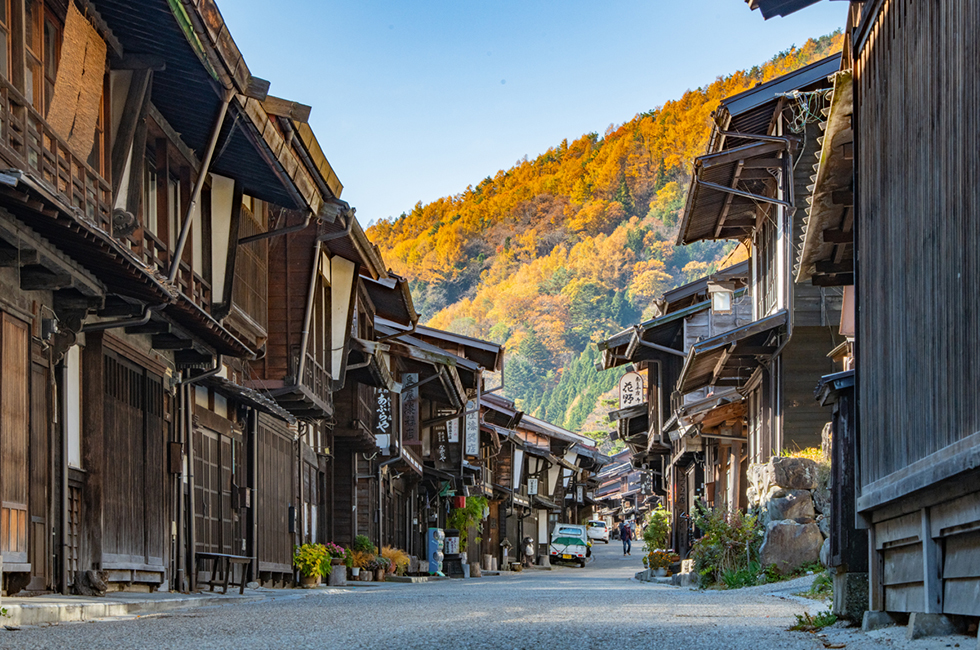
The streets of Narai-juku. With the lush forests of Kiso as a backdrop, the scenery of old houses continues for about one kilometer.
A project team in which a professional calls a professional
In this project, new life was breathed into buildings with roughly 200-year histories, such as the main building and storehouse of Suginomori Shuzo, a sake brewery which had been closed since 2012, and hoihoi, a former guesthouse located about three minutes away.
The facility was named BYAKU Narai to represent "an inn that delivers 100 experiences lying within the community to guests, and leaves 100-year-old architecture to the future."
- (1)BYAKU Narai is an accommodation facility with 12 rooms where guests can stay in a traditional Japanese house.
- (2)A local restaurant, kura, uses local ingredients selected by a world-famous chef and serves dishes that can only be enjoyed there.
- (3)suginomori brewery is a sake brewery that has been revived and rebranded from the old Suginomori Shuzo, once a symbol of the local community.
- (4)TASTING BAR suginomori is a bar where visitors can enjoy local alcohol, including sake from suginomori brewery.
- (5)SAN-SEN is a hot spring bath facility where visitors can soak in the mountain water of the Shinano River – water that is also used as the water source for suginomori brewery.
- (6)Gallery hoihoi tells the history of Narai-juku's buildings and town.
To start the project team, we reached out to professionals in various fields. First, Salt Terminal Co., Ltd. rented a kominka* from the building owner and worked with the Takenaka Design Department to renovate the old house. In addition, Narai Machiyado Co., Ltd., a new company established by 47 Planning Co., Ltd., who works to resolve local issues, rents the renovated kominka and is responsible for planning and operating the entire facility (except for sake brewery).
In addition, 47 PLANNING and ONESTORY Co., Ltd., who produces the magical restaurant "DINING OUT" that opens somewhere in Japan for only a few days, approached us and asked to produce the restaurant. In addition, Kiraku, Inc., which specializes in kominka ryokan* renovation projects and regional revitalization, took part in the revival of the sake brewery. Tsubame Architects, Inc. took part in the renovation design of hoihoi, a former guesthouse, and NOSIGNER Co., Ltd. took part in the direction of the hotel's branding and sign design.
- *Kominka: an old-style Japanese house.
- *Ryokan: a type of traditional Japanese inn.
Continue "dialog" with the buildings
For the renovation of Suginomori Shuzo, where the renovation design was done by our company, the important points were to carefully "talk" with the space, frame, and construction of the existing building to select what should be left, and to build a safe, secure, and comfortable space, which despite being an old private house, would ensure the performance of guest rooms in terms of heat insulation, sound insulation, and earthquake resistance.
In its 200-year history, the buildings renovated on this occasion had been reworked many times to match the lifestyle of the times. Because the buildings were 200 years old, of course there were no detailed plans from the time of construction. Our designers visited the site many times, repeated surveys and measurements, and continued to interact with the buildings.
In addition to some drawings from the Meiji period that were discovered during the site survey, the layout and structure of each room at the time of its construction, as well as stories from previous residents and the historical background, were used as hints to decipher the architectural style of the time and to derive the contexts of hare and ke*, mise and oku*. The rooms close to the street are simple and plain mise, and the rooms facing the courtyard which cannot be seen from the street are tasteful oku. The hare used by the masters, and ke used by the servants. In designing the renovation, we took care to keep these contexts prominent.
- *Hare and ke: In Japanese folklore and cultural anthropology, hare is said to be the "unusual" such as ceremonies, festivals, and formal events, and ke is said to be "everyday" things. Food, shelter and clothing, behavior, and language will vary depending on hare and ke.
- *Mise and oku: In townhouses of the Edo period, many of which of conducted some kind of business, mise was essentially the storefront facing the road, and oku, which faced the back garden side, was a hospitality space to invite guests as well as a family living space.

For example, in the 105 room, where the oku and hare intersect, we have renovated the guest rooms into authentic shoin-zukuri*-style rooms, taking full advantage of the building's existing shoin (study alcove) and transoms, and enabling exclusive courtyard use by guests. The 103 room, where the mise and ke intersect, reveals powerful beams and a koyagumi* tinged by smoke from a kamado*. Having an atrium whereby it is apparent that it had once been a katteba*, the room was made into a spacious duplex-type room.
We designed all eight guest rooms at the former Suginomori Shuzo in this way. Each room has its own unique character and story, such as the 107 and 108 rooms where a lucid ambiance lingers of being surrounded by the earthen walls of a former household goods storehouse. As the detached former hoihoi Minshuku has an additional four guest rooms, visitors can enjoy a fresh experience in 12 different guests rooms no matter how many times they visit.
- *Shoin-zukuri: A style of Japanese architecture that spanned several periods in the middle of the last millennia and forms the basis of today's traditional-style Japanese house. Characteristics include square pillars, wall-to-wall tatami mat flooring, a decorative alcove in the main reception room, staggered shelves, and built-in desks. The style takes its name from shoin, a term that originally meant a study and a place for lectures on the sutra within a temple, but which later came to mean just a drawing room or study.
- *Koyagumi: The roof framework in traditional Japanese architecture.
- *Kamado: Traditional Japanese cooking oven.
- *Katteba: An old-style kitchen with a kamado.
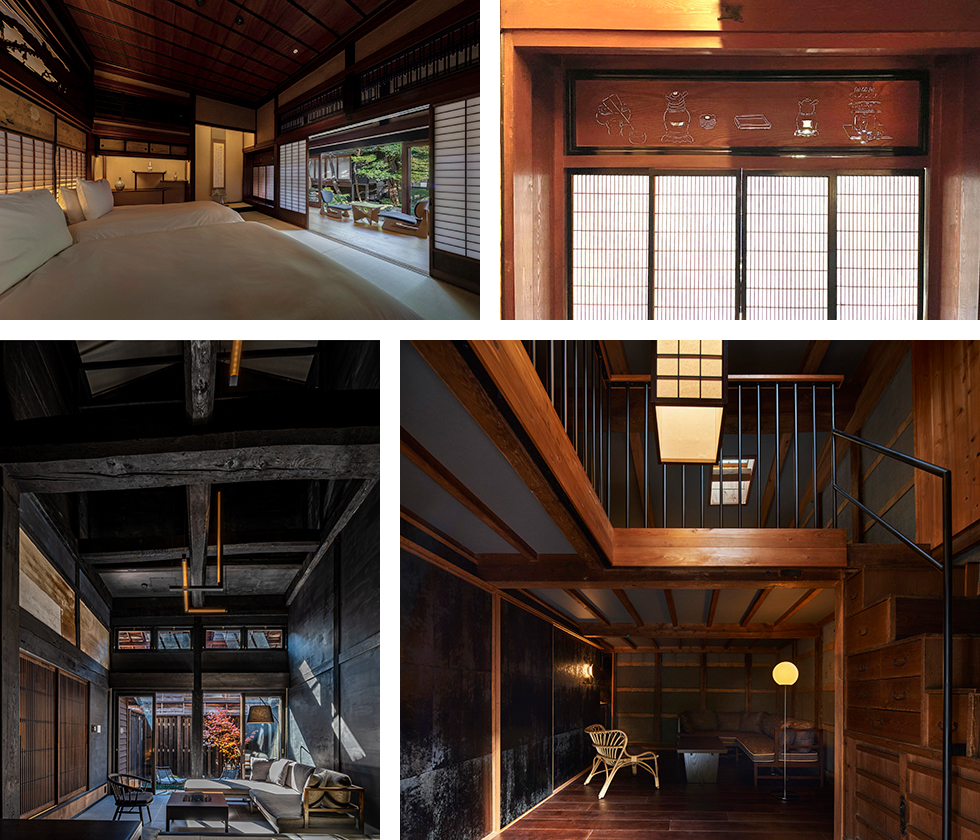
Upper level: 105. It is a genuine shoin-zukuri style room with a garden, and the interior is furnished with a shoin (study alcove) and transoms.
Lower level, left: 103. This is the largest room in BYAKU Narai, where the former katteba was rediscovered.
Lower level, righ: 107. A local lacquer artisan used Japanese lacquer paper to finish this guest room. This recreated a household goods storehouse that had previously contained a lot of lacquerware and furnishings.
Connecting with stories of the buildings and community
The restaurant, kura, was originally a two-story storehouse for sake brewing. By removing the ceiling of the first floor, we created a space that made the most of the large openness of the storehouse, such as the beams and columns that appeared and the strength of the stucco wall that had changed over time. The lighting hanging from the ceiling is a custom-made arrangement of itto* bottles that had been stored at the original brewery, and there is a history of the buildings and town everywhere, such as Kiso lacquerware, which is a specialty of the Kiso-Hirasawa district in a neighboring town, being used for food containers.
- *Itto: Traditional "one sho" bottle (1.8 liters)

A restaurant with a high ceiling and a sense of liberation, and local ingredients used in some menu items
At the SAN-SEN hot spring bath facility, visitors can experience the power of nature in the Kiso Valley through their entire body by immersing themselves in the soft mountain water from the headwaters of the Shinano River, which is also used for brewing sake. They can then warm themselves with natural energy from a biomass boiler in the interior space with the fragrance of Kiso-Goboku*. Gallery hoihoi offers visitors the opportunity to learn about the history of Narai-juku, and it has been designed to give users a sense of the connection between the community and the story of Narai-juku in various situations.
- *Kiso-Goboku: Five types of trees whose logging was banned during the Edo period to protect forest resources(Hinoki, Sawara, Nezuko, Koyamaki, Asunaro) .

Left: A hot spring bath facility. Visitors can smell the nice fragrance of Kiso-Goboku.
Right: Gallery hoihoi (designed by Tsubame Architects, Inc.). Visitors can also see the planning concept story of this project.
Community development in cooperation with local communities
Our company's urban creation is not limited to the large-scale redevelopment of urban areas that many people imagine. The project at Narai-juku and the activities in Unnan City, Shimane Prefecture, and Ogawa-machi, Hiki-gun, Saitama Prefecture are gradually starting to play a role in regional revitalization by collaborating with local people and professionals in various fields.
We will hold repeated dialogs with local people to solve respective problems faced by their communities, struggle together with them on these issues, and continue to promote better "urban creation" on occasion with the help of these other professionals.

The opening ceremony in August 2021, officials and local residents gathered to celebrate the opening of the facility.
Voices of project members
In charge of Planning / Promotion, Yohei Takahama
In rural areas, there are many valuable buildings bearing the culture, tradition, and history of the region that are in danger of continuing to exist, such as vacant buildings due to the relocation of owners or closure of businesses. As our company descended from master builders, we will find new usage and users for valuable architecture, and we will breathe new life into buildings by adding modern renovations to comfortably use them long into the future. This will become the core of our revitalizing local communities. I thought this was one of the missions of our company, which livelihood is from architecture, so I endeavored to work on it.
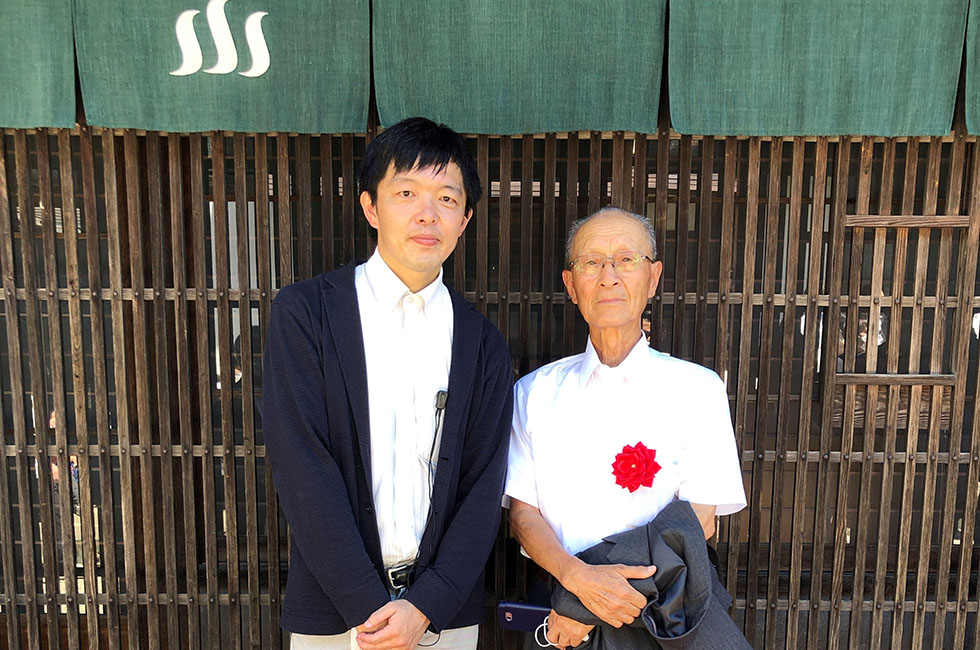
On the right is Mr. Uehara, the owner of the building before the renovation to BYAKU Narai.
In charge of design, Yuma Hasegawa
Through careful dialog with historical backgrounds and the spaces, structures, and arrangements of existing buildings, we added new functions while making the most of the things we should have left, and rebuilt this facility into a space with fresh surprises and discoveries. I hope that these buildings will be closely related to the town and that it will be passed on to the future along with the town history.
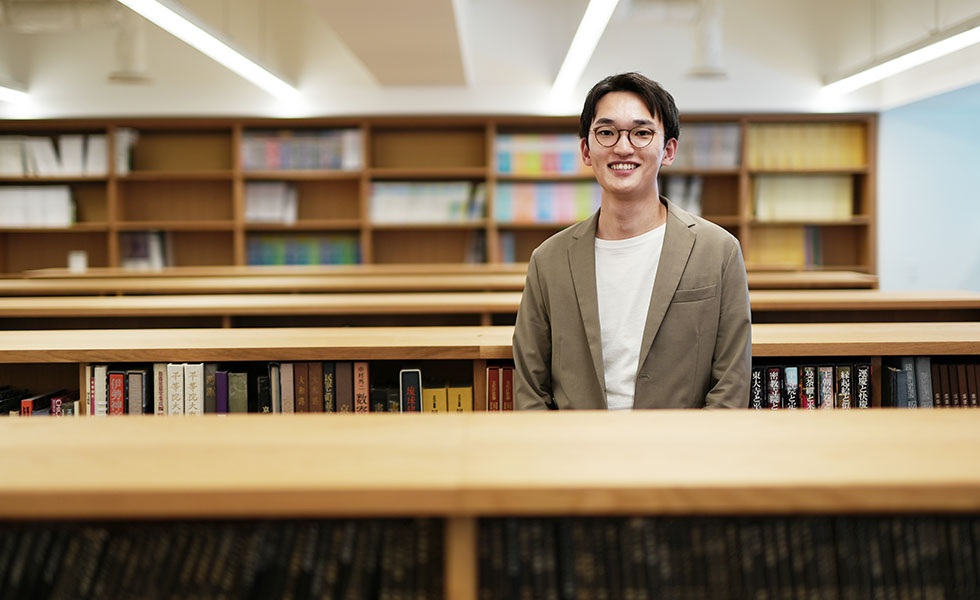
Mr. Kenji Suzuki, Narai Machiyado (Representative Director, 47 Planning Co., Ltd.)
I believe that towns and regions are revitalized only when the thoughts of outsiders and insiders overlap. Through "BYAKU Narai," an inn that connects directly with the local community through 100 experiences, we want to extend many lines of connection with the local community, form a strong community and grow together, and pass on regional treasures to the next generation.
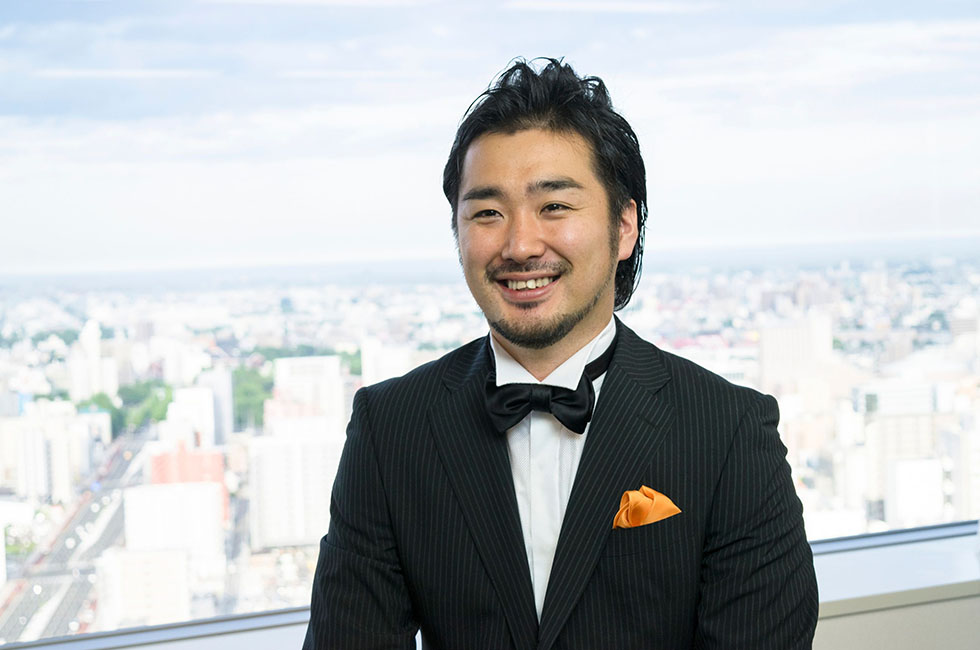
Mr. Kou Sundberg, suginomori brewery (Representative Director, Kiraku, Inc.)
It has been a great pleasure to participate in this interesting project. Working together with master brewer Irie and taking on the challenge of sake manufacturing for the first time, we were able to create narai, a very delicious sake that expresses the nature of its home, Nagano. It is my hope that many people will visit us to enjoy it. It has only just begun, but together with the people of the Narai-juku and those involved in the project, I am looking forward to seeing the development of the town in the future.
